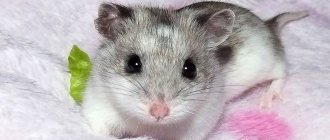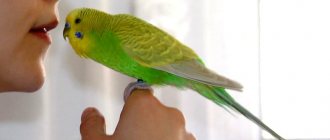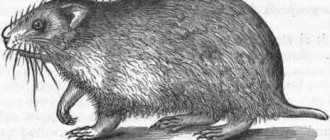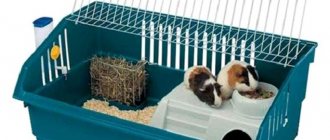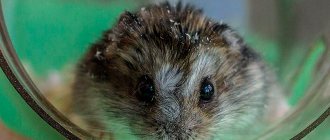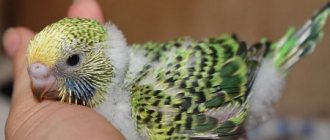- home
- General information
15.04.2018
Noise, fuss, and the patter of little paws are an integral part of life with a hamster. Babies make these sounds at night, during periods of activity. The nocturnal activity of hamsters brings discomfort to the owner of the furry creatures. Animals disturb sleep and frighten owners. Many owners are perplexed: why does the hamster chew on the cage when there are enough toys and “tools” for sharpening its teeth in the house. Let's look at this issue further.
Is it harmful for a hamster to chew on cage bars?
Before weaning your hamster from chewing its cage, you should understand the dangers and consequences of this habit. First of all, such behavior of a furry pet is accompanied by strong grinding and fussing, so it will prevent you and your loved ones from sleeping peacefully at night. If a pet chews on its cage regularly, this jeopardizes its health and life.
The material from which the rods are made is quite durable. It is almost impossible to grind off, so the hamster can damage his teeth. In natural conditions, rodents use pieces of wood or crunchy food, which is much softer than the elements of the cage, instead of metal objects.
In addition, quite often the rods are treated with paint, which gradually crumbles and ends up in the stomach. Even if the animal tolerates eating foreign substances normally, there will be no benefit to its health from this.
Number of teeth
Surely, you will be interested to know how many teeth a hamster has - Djungarian, Syrian and others. It is very difficult to count them yourself, since the rodent, like other animals, does not like it when people look into its mouth. Most people think that a fluffy's mouth consists of a pair of large teeth on the upper and lower jaws.
In fact, the animal has 16 teeth in the oral cavity - the same 4 incisors in front and another 6 lateral molars, which do not stand out at a superficial glance at the animal’s mouth. Their role in the body is very important - with the help of the incisors, the pet grinds, and with the lateral molars, chews all the food before it enters the gastrointestinal tract. To examine, pull the animal by the mane and slightly move the cheek pouches.
Inexperienced owners may be concerned about why their hamster has yellow teeth. Don’t worry, this enamel color is normal for them, and not a sign of any pathology or a consequence of poor nutrition.
The shade of the enamel may change to a darker color when the animal consumes food with a high content of dyes. Give preference to cereals, fresh fruits and vegetables. It is also possible that the darkening is age-related: your pet is simply getting old.
Reasons for behavior
There are various reasons why Syrian hamsters and dwarf hamsters begin to chew on cage bars. In most cases, this is due to the natural instincts of the rodent, but sometimes it is explained by other factors.
Hunger or thirst
If your hamster chews on the bars periodically, it may mean that he is hungry. Pets often attract the attention of their owners in this way to spoiled or depleted food supplies in the cage.
If your hamster is chewing on its cage, it may be hungry.
Desire for communication
Animals may chew on surrounding objects if they are bored. Due to restrictions on natural activity in the cage, the hamster is constantly looking for new activities. In the wild, rodents spend all their time outdoors, moving. They dig holes, search for food and make provisions for the future. They also often hide and run away from predators.
In apartment conditions, the list of activities is much narrower, so the pet is forced to look for alternative ways to do something in his spare time.
Grinding down teeth
This is a physiological feature of hamsters, which belong to the class of rodents and are forced to grind down their incisors. The pet would be more happy to gnaw on dry tree branches, plant roots or other food, as it does in the wild. But in the limited space of the cage there is no such opportunity, so he begins to chew on the metal bars.
Lack of sleep
Hamsters, like other pets, need healthy sleep. Therefore, it is important for owners to provide the pet with the most comfortable conditions for rest by installing a house in a cage, or covering the rodent’s home with thick fabric.
Hamsters need to sleep in comfortable conditions.
Small "living space"
As the hamster gets older, the space in the cage becomes limited. He wants to walk in an open space and begins to constantly chew on the bars, both during the day and at night. Therefore, check whether the rodent has become cramped, and if there is a lack of free space, be sure to replace the cage.
Proper nutrition
There is a wide variety of food for rodents on display at pet stores. However, despite what the labels say, not all of them are created equal. Cheap food is not suitable for feeding hamsters - they are usually of poor quality, incorrectly balanced, and do not contain all the necessary substances and vitamins. There have been cases where rodent poison was found in food, which caused the death of pets.
For normal functioning, hamsters need balanced dry food. It should include cereals, plant seeds, herbs and flowers, as well as protein supplements in the form of dried insects.
It is important to give hamsters allowed vegetables and fruits. You can feed hamsters cucumber, zucchini, broccoli, cauliflower, lettuce, turnips, radish
Types of hamsters that are not predisposed to diabetes can be given pumpkin, carrots, fruits and dried fruits.
It is forbidden to give onions, white cabbage, sorrel.
Nuances of weaning a hamster
Before replacing your hamster's cage, you need to pay attention to its condition and check whether it meets the following requirements:
- Has enough space to accommodate the animal.
- Equipped with tunnels, slides and a wheel.
In the behavior of dzhungariks there is a pronounced tendency to escape, so they gnaw on the bars in the area where they exit the cage. Representatives of the Syrian breed are considered to be calmer, and if they have not chewed on bars before, this behavior may be due to a lack of other activity.
If you find that your hamster has started to engage in this habit, offer him a stick or twig to replace one activity with another.
Maintain gentle persistence and be attentive to the animal's wishes.
Useful tips
To make the search for the fugitive successful, follow simple rules:
- If there are other pets living in the apartment, move them away from the place where the hamster is supposed to be.
- When using mousetraps, be sure to remove them so that the animal does not get caught in them.
- Once you find an animal, limit its movement around the apartment. To do this, close all exits from the room.
- To avoid scaring the tiny creature, do not make loud or harsh sounds.
- Quite rarely, a hamster can be found in the folds of clothes, towels or bed linen - he climbs there to keep warm.
Check the cage regularly to eliminate defects in a timely manner, and ensure that the door is closed tightly. Make sure your pet is comfortable in his house and there are no irritating factors nearby. Give the animal more time and buy toys if necessary. The best way to catch a hamster is to prevent it from escaping.
Ways to wean a rodent from damaging its cage
The first thing you need to do when weaning a hamster from a bad habit is to determine the cause of its occurrence. If the behavior is related to a physiological factor and the pet’s desire to grind its teeth, it is enough to provide it with alternative objects for this. If problems arise due to lack of space in the cage, boredom and lack of proper rest, you should reconsider the living conditions and care of the animal.
Walking around the apartment and chatting
When figuring out what to do if a hamster chews on its cage, start periodically walking it around the apartment. You can try to conduct such walks every day so that the rodent gets plenty of exercise and spends all the accumulated energy. You can monitor the animal yourself, limiting its movement, or set up a miniature pen in a safe part of the room (where it will not be able to hide and find a hole).
If the hamster chews on the cage, it must be released.
Over time, hamsters adapt to walking, so they themselves go to the cage (if it is nearby) to rest or eat. If it is not possible to organize such a walk, you need to purchase a special walking ball for your pet. It will create freedom of movement, but will prevent the rodent from escaping.
Feeding with treats
Pet stores sell hard treats for hamsters. Pets show special interest in cereal sticks with honey. You can also buy vegetable tartlets or treats with grains and nuts.
It is important to include vegetables and fruits in your diet. In addition to juicy soft food, it is necessary to feed your pet solid foods every day. Rodents love sweet bell peppers, apples and carrots.
Mineral stones
Since the need to grind teeth accompanies hamsters throughout their lives, it is necessary to provide the pet with hard and safe accessories. If it is not possible to place branches and other natural objects for the animal in the cage, it is necessary to use mineral stones, which are sold in pet stores. The pet will grind its teeth on them without creating unpleasant sounds.
Branches
Branches of fruit trees, including pear and apple trees, can help solve the problem. But before feeding the shoots, you should pre-treat them by clearing the bark of moss and dirt, and then rinsing it under hot water to remove microorganisms. After this, the branches should be doused with boiling water, cooled and fed to the animal. In pet stores you can find ready-made hazel sticks that are suitable for grinding down teeth.
Repellents
If the above methods do not bring positive results, you can buy a special repeller for hamsters. In most cases, it is made from natural substances that irritate the hamster and emit an unpleasant odor. The method of using the funds is quite simple.
It is necessary to remove the pet from the cage, and then treat the rods with a repellent composition and wait until they dry. After this, you can return the rodent to its place. When he gets down to his usual task, he will strongly dislike the aroma and unpleasant taste of the twigs, so the desire to chew through the cage will gradually disappear.
Possible problems
Ornamental animals at home are often deprived of the instincts and way of life that are inherent in their relatives in the wild. That is why this often leads to many problems, including those with the oral cavity.
That’s why, regardless of age and living conditions, your pet should be given attention every day
What to do if your teeth don't sharpen
A huge number of hamster owners face this problem. It often occurs as a result of an unbalanced diet or if the animal’s natural instincts at home are somewhat dulled. Often this phenomenon is accompanied by general lethargy of the rodent or other symptoms indicating systemic ailments. Therefore, it is recommended that your hamster be thoroughly examined by a veterinarian.
If the rodent is completely healthy and simply does not have time to wear down its teeth, they definitely need to be trimmed. To do this, you need to take nail scissors or nail clippers for cats. This must be done carefully, with smooth movements, up to a length of 5 mm. At the same time, it is also recommended to trim the claws on the paws so that the hamster does not injure himself and others. However, it is recommended to do all this at home only if you have the appropriate skills. In other cases, it is strongly recommended to consult a veterinarian.
Broken upper or lower tooth
Also, often during active games, an animal can break its front incisor. In this case, the lower or upper tooth can break on its own, due to an unbalanced diet or in adulthood. If you do not take decisive action, this can lead to serious problems in just 1-2 weeks.
First of all, the sharp edge can injure the oral cavity, which will cause many difficulties for proper nutrition. It should also be taken into account that the incisors do not grow synchronously, so over time the difference between the length of a healthy and broken incisor will be significant. To prevent all this from happening, the broken incisor must first be polished with a nail file. After this, the adjacent long tooth must be shortened to the length of the broken one.
Uneven growth of incisors
This problem can arise due to a number of factors, which also include genetic predisposition and the impact of closed living conditions. That is why it is not easy to accurately answer the question of why this happens. This pathology can take on a varied type of course, with each incisor growing either asynchronously or in pairs. In the latter case, there is a pathological enlargement of the two lower or two upper teeth, which can reach truly gigantic sizes.
What to do if your teeth are chattering
Sometimes a characteristic knocking sound may indicate problems with teeth. This occurs due to an incorrect taste caused by excessively long incisors. As a result, the pathological process leads to unpleasant or painful sensations that contribute to severe discomfort. This is especially evident with uneven growth of the incisors and subsequent distortion of taste.
However, a hamster can chatter its teeth even with a whole range of ailments, including cancer. That is why, when such a problem occurs, you need to contact a veterinarian as soon as possible. Often this will help prevent the development of serious consequences and death of the pet.
With the help of unpleasant mixtures
To stop animals from chewing the cage, you can use some unpleasant mixtures. It is possible that they smell unpleasant or have a strange taste. Of course, you can’t use any toxic substances; you don’t want to see an already dead animal one morning.
Experts believe that you can use red pepper, it has a rather unpleasant taste and the animal will never want to touch or lick it again. It is also recommended to use lemon juice.
You must be careful, as a large concentration of pepper or lemon juice can lead to poisoning or intoxication. Therefore, apply a little juice so that there is only an unpleasant tint. Then he will not chew off the metal, but what you put in front of him.
Home living
Your pet does not have to worry about food, because you constantly fill his feeder with nutritious grains. Often, owners even overfeed their pets. “But how can that be? - you object. “After all, I fill the bowl exactly according to the instructions.” It's not even that he eats a lot. He just has nowhere to waste his energy. He imposingly strolls from the house to the feeder and crunches ready-made grains that do not need to be dug up or chewed off. But you can't argue against nature. Teeth continue to grow at the same rate as their wild counterparts. That's why the hamster chews the cage, it adjusts their length.
Gastrointestinal diseases
There are various diseases of hamsters that are caused by pathogenic microorganisms. Among them, veterinarians identify pathologies of the digestive tract. They cause gastrointestinal disorders, and in severe cases can lead to the death of the animal.
Worms are also common in hamsters, which enter the body along with contaminated food or water. The disease can be determined by the slow growth of young animals, sudden weight loss (with normal nutrition), problems with fur (for example, oily sheen)
It is also worth paying attention to the consistency of the stool: it becomes soft, the mass contains blood, mucus or fragments of parasites
Colibacillosis
This disease in hamsters is caused by E. coli. Colibacillosis is also called “wet tail”. This is because loose stools cause the fur around the hamster's anus to be wet.
The disease occurs as a result of the penetration of E. coli into the body. The source of infection is contaminated food or water.
You can tell that your hamster has colibacillosis by the following symptoms:
- watery diarrhea with a pungent odor;
- decrease or disappearance of appetite;
- weight loss;
- anxiety;
- depression, lethargy, apathetic state;
- exhaustion of the body;
- sometimes high temperature;
- uncertain movements;
- increased heart rate and breathing.
Specific signs of colibacellosis are loose stools and wet fur around the anus. The hamster is constantly trying to find a secluded place and curl up into a ball. He looks sloppy, his fur is disheveled, his ears are flattened, he doesn't move much.
The disease develops quickly, so treatment must be started in the early stages. Therapy is carried out under the supervision of the attending physician. The infection should be treated with electrolyte solutions and antibiotics (tetracyclines are often used). The former improve the hydration process, while the latter destroy bacteria in the intestines.
Therapy is carried out at home. During the treatment period, you must follow the diet prescribed by the ratologist.
Escherichia coli
Hamster diseases caused by E. coli can lead to the death of the pet. The infection begins to develop after a pathogenic microorganism enters the animal’s body, which begins to multiply rapidly. Because of this, the natural intestinal microflora changes, and the hamster’s condition deteriorates sharply.
Signs of an illness caused by E. coli:
- high body temperature;
- diarrhea with blood streaks;
- weakness, apathy;
- the animal does not eat anything;
- weight loss;
- blanching of the mucous membranes.
The infection progresses quickly and often ends in the death of the animal. To prevent this from happening, when the first symptoms of the disease appear, you need to contact a ratologist. The doctor will prescribe a bacteriological analysis to identify the pathogen and develop treatment tactics. Intestinal antiseptics and antibiotics will help destroy the source of infection.
You can get E. coli from a sick hamster. To avoid this, a person should thoroughly wash their hands with soap after contact with the animal. To prevent illness, you should keep your home clean.
Enteritis
This is a disease in which the inflammatory process affects the small intestine (some parts or all of it). As a result, its functionality is impaired, and dystrophic changes appear on the mucous membrane. Then various digestive disorders arise.
The main reason for the development of enteritis in a hamster is considered to be the lack of hay in its diet. The disease is manifested by increased gas formation in the intestines and diarrhea.
Enteritis is treated by introducing high quality hay into the hamster's diet. Specific therapy is also carried out: the feces of a healthy animal are diluted with water, and then administered through an enema into the patient’s intestines.
Why do Hamsters die?
A hamster may die during childbirth if she is less than 4 months old or has too many babies. Other reasons. A hamster can run away and suffocate somewhere under the floor in a cramped hole, or it can chew through an electrical wire and receive an electric shock.
Interesting materials:
How to plant raspberries in the fall? How to plant daily raspberries? How to plant blackberries in spring? How to plant beans and beans? How to plant beans in open ground? How to plant phlox from seeds? How to plant freesias in the fall? How to plant a lawn in the fall? How to plant lawn grass seeds in spring? How to plant lawn grass in spring?
How to avoid fights between pets?
Many people wonder what to do when hamsters fight. First of all, you should take care of stopping the bloodbath. Since pets from the hamster order have rather sharp incisors, they can seriously injure a person if he tries to separate the fighters with his bare hands. It is best to disperse the hamsters to different corners using improvised means and immediately get one of them.
The only way out of this situation, which explains what to do, is to resettle the hamsters. You shouldn’t let the situation lead to real bloody slaughter, because in the daytime, when individuals are least active, you may not notice that they have certain disagreements in dividing the territory. These animals are nocturnal predators, and therefore, most likely, only in the morning the owners will be able to see traces of the struggle between them.
When moving dwarf hamsters into one home, it is worth remembering that it should be as spacious as possible. In addition, there should be enough attractions such as running wheels, houses with several floors, allowing children to move freely in them. Otherwise, disagreements that cannot be resolved peacefully will arise between individuals of this breed.
Which hamster is suitable for a child?
If a pet is bought for a very young child, parents need to be prepared for the fact that the parents will have to care for the rodent.
If the child is already quite conscious - over five years old - then he can choose the hamster himself, depending on his own preferences. Perhaps the child will want to teach the rodent small tricks (fetching a piece of paper, jumping through a ring, running along a given path). Djungarians are suitable for such purposes - they are very trainable, more temperamental and a little smarter than their larger counterparts.
If the child wants to constantly “squeeze” the baby,


